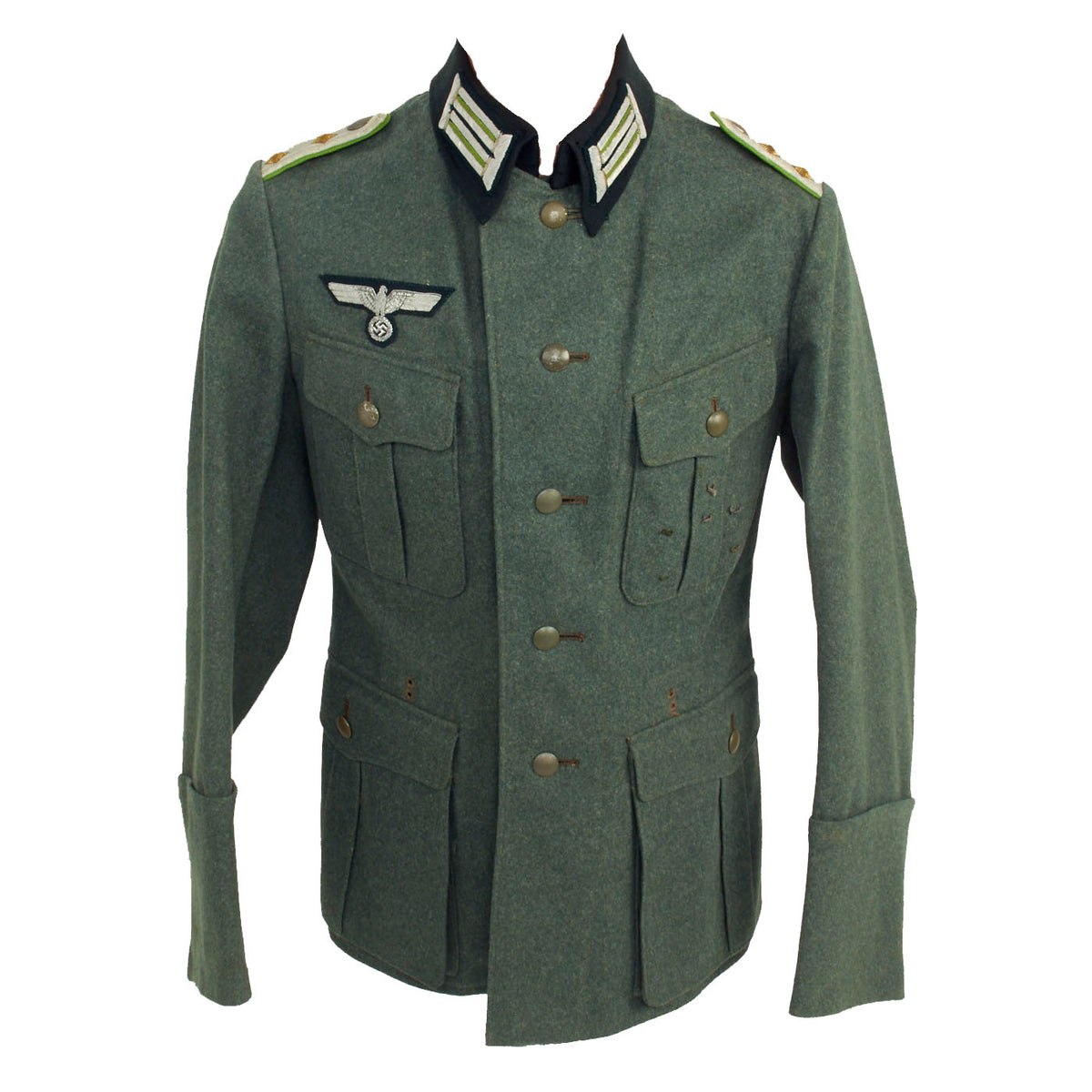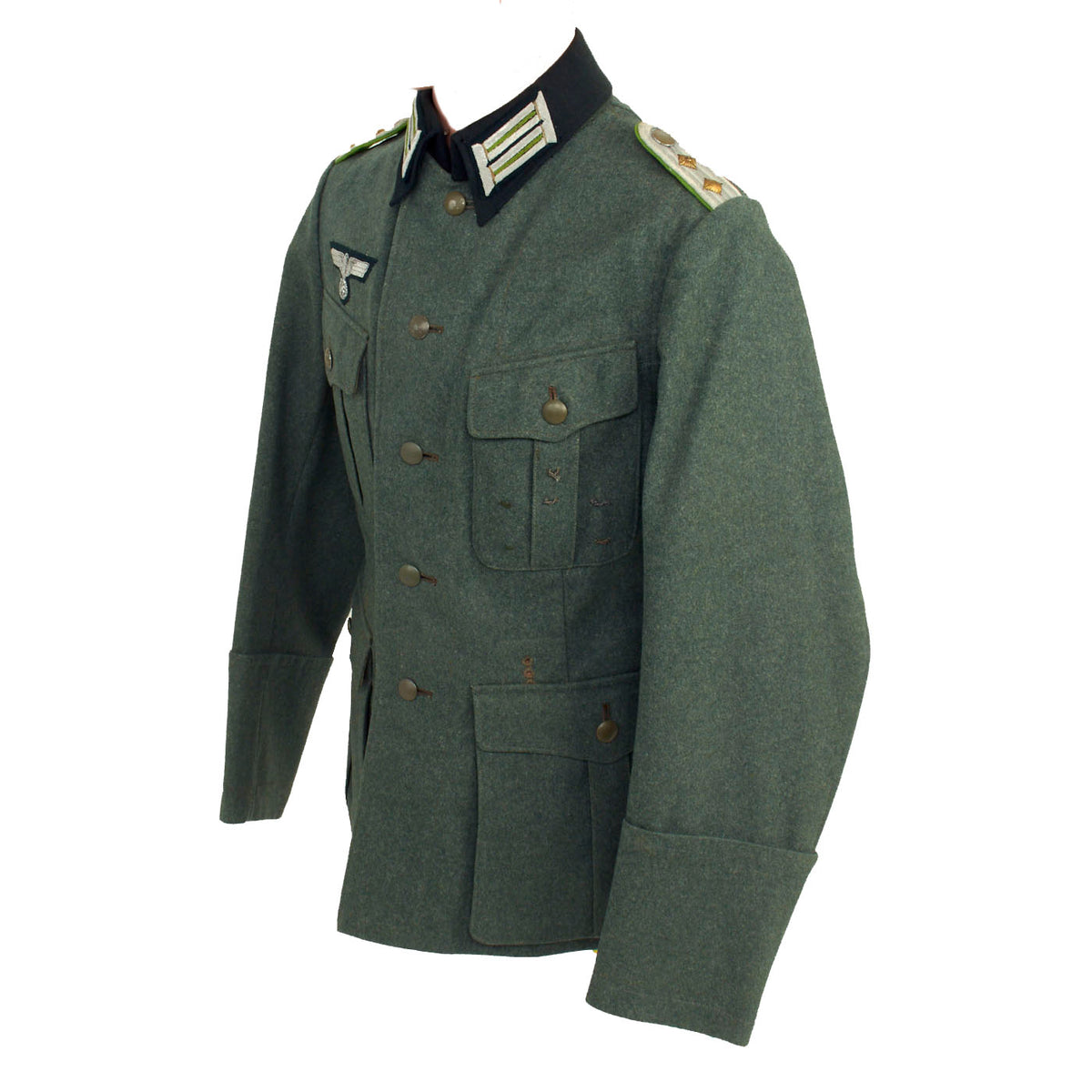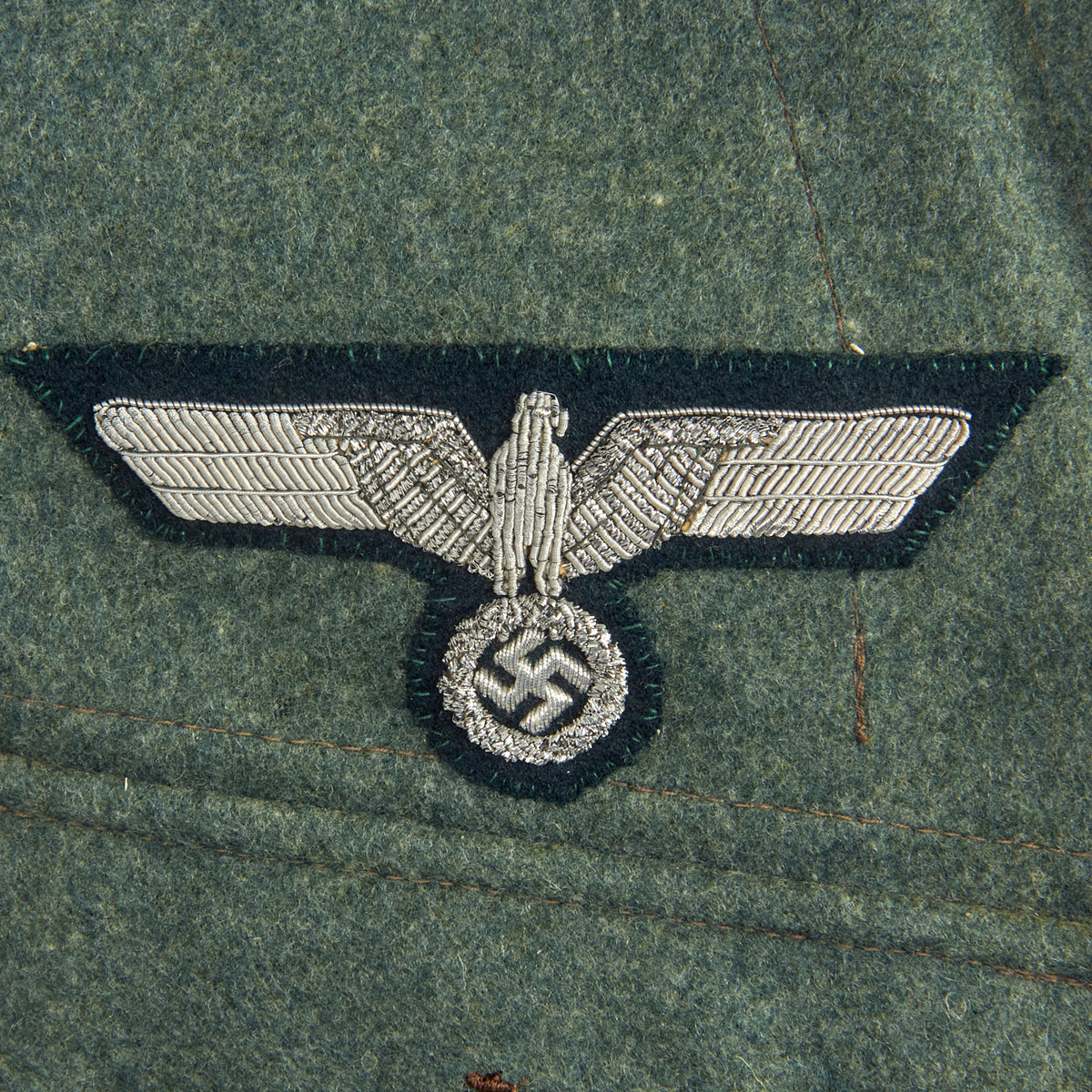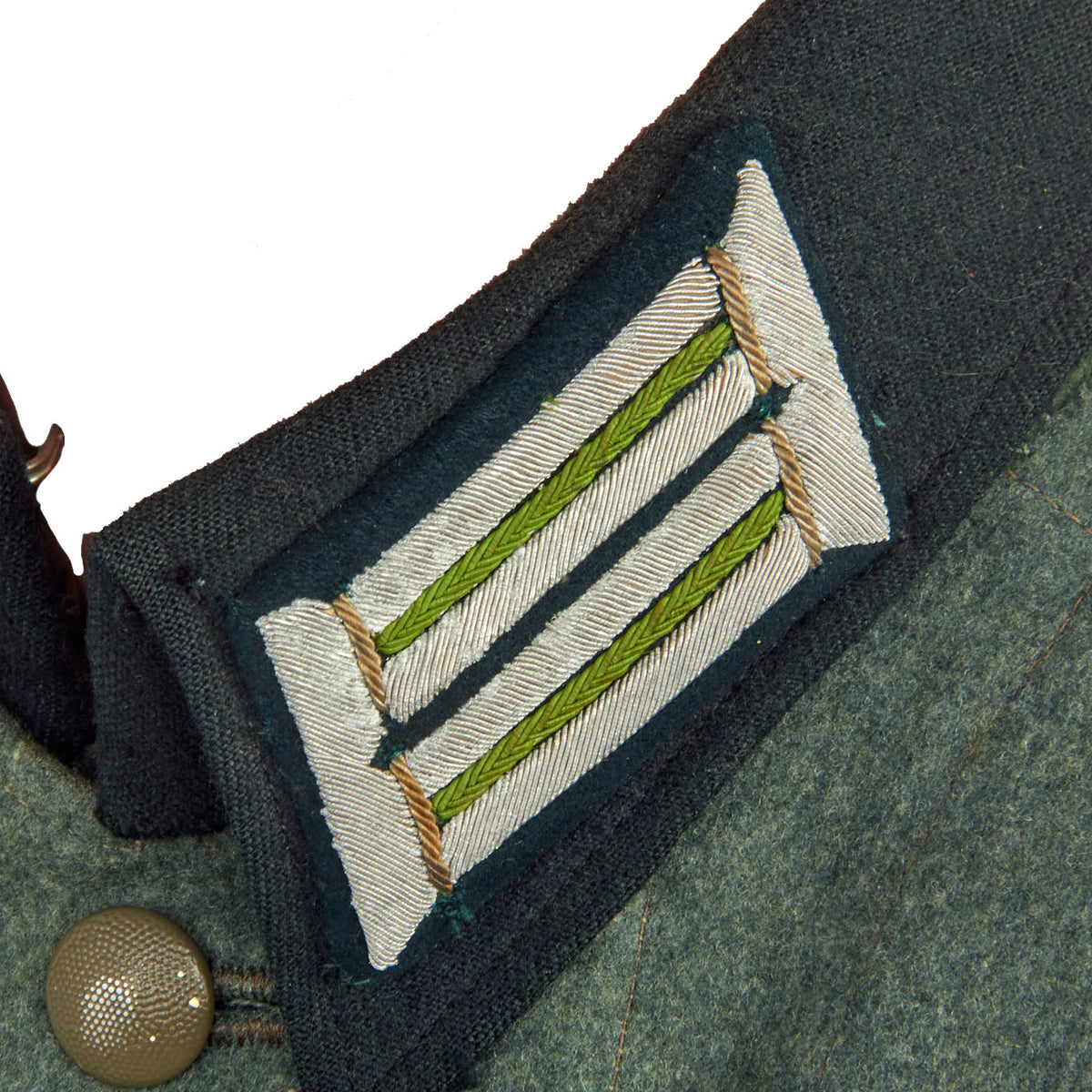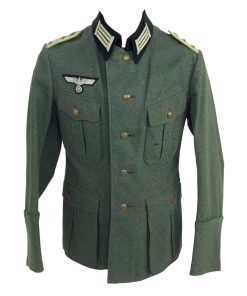Original German WWII Heer Panzergrenadier Hauptmann Officer’s M36 Field Tunic by Schmidt & Zoltsch, Munich Original Items
$ 1.995,00 $ 498,75
Original Item: Only One Available. This is a very nice later pattern German WWII Heer Army M-36 Tunic, showing only light wear and in very good display condition. The inside of the right breast is marked by maker SCHMIDT & ZOLTSCH / MÜNCHEN, along with the sizing information, as well as the correct M.36 designation for the type of tunic it is. The tunic features four pockets with scalloped flaps and green painted pebbled aluminum buttons, and has a five button front closure, with two “hook and loop” fasteners for the collar. The buttons on the tunic are sewn directly to the fabric, not attached with metal circlips.
It is adorned with the usual rank and branch insignia used on German tunics. The attractive Army breast eagle is the correct officer’s silver bullion hand embroidered type on a green background, and is very neatly hand stitched to the chest in a fashion typical of wartime German tailor work.
The collar is wrapped in a dark-green wool, has officer’s field litzen collar patches on each side, which are woven from silver bullion thread with a dark green background matching the collar. The colored stripes on each are Wiesengrün (Meadow Green), the Waffenfarbe (corps color) for the Heer Panzergrenadiertruppen (Panzer Grenadier Troops). These were motorized / mechanized infantry troops, and were legendary in the field. Originally called Schützen regiments, they had used the same Pink piping as the Panzer corps. Then in 1942 Infantry Regiments were renamed as Grenadier Regiments by AH as a historical homage to Frederick the Great’s Army, and the Schützen were renamed to Panzergrenadiers. The collar is in good shape, tough there is a bit of wear around the edges, which is usually one of the first places to show damage from use.
The “sew-in” style company officers schulterklappen (shoulder boards) of this tunic are constructed with two rows of fine silver flatware “Russia Braid” double piping and have the correct Meadow Green piping around the edges. Each features two gold pips, which denote the rank of Hauptmann (Captain). There are some thread loops on the left breast where medals were once displayed.
Overall condition is very good, with just a bit of light wear and staining consistent with service. We did not really notice any holes or other major danage, and overall it displays very nicely. Ready to out fit with medals and display!
Approximate Measurements:
Collar to shoulder: 10”
Shoulder to sleeve: 27.5”
Shoulder to shoulder: 16.5”
Chest width: 20”
Waist width: 18”
Hip width: 19.5”
Front length: 31.5″
Terms such as M40 and M43 were never designated by the Wehrmacht, but are names given to the different versions of the Model 1936 field tunic by modern collectors, to discern between variations, as the M36 was steadily simplified and tweaked due to production time problems and combat experience.
Field Tunic (Feldbluse) Model 1936
When the NSDAP came to power in early 1933 the Reichswehr, the armed forces of the Weimar Republic, were near the end of a two-year project to redesign the Army Feldbluse (field-blouse). Beginning in that year the new tunic was issued to the Reichsheer and then the rapidly growing Wehrmacht Heer, although minor design changes continued to be made until the appearance of the standardized Heeres Dienstanzug Modell 1936. The M36 tunic still retained the traditional Imperial and Reichswehr uniform color of grey-green “field gray” (feldgrau) wool, but incorporated four front patch pockets with scalloped flaps and pleats (on Reichswehr tunics the lower pockets were internal and angled). The front was closed with five buttons rather than the previous eight, and the collar and shoulder straps were of a dark bottle-green instead of the Reichswehr grey. Compared to the Weimar-era uniforms the skirt of the feldbluse was shorter and the tailoring was more form-fitting due to Germany’s adoption of mechanized warfare: soldiers now spent much time in the confined space of a vehicle and a shorter jacket was less likely to pick up dirt from the seats. It also included an internal suspension system, whereby a soldier could hang an equipment belt on a series of hooks outside of the tunic. These hooks were connected to two straps inside the lining, which spread the weight of equipment without having to use external equipment suspenders. The M36 was produced and issued until the very end of the war, though successive patterns became predominant.
SS field uniforms were of similar appearance externally but to fit their larger patches had a wider, feldgrau collar, and the lower pockets were of an angled slash type similar to the black or grey SS service-dress. The second button of an SS Feldbluse was positioned somewhat lower, so that it could be worn open-collar with a necktie. Due to supply problems the SS were often issued army uniforms.
Fast Shipping with Professional Packaging
Thanks to our longstanding association with UPS FedEx DHL, and other major international carriers, we are able to provide a range of shipping options. Our warehouse staff is expertly trained and will wrap your products according to our exact and precise specifications. Prior to shipping, your goods will be thoroughly examined and securely secured. We ship to thousands clients each day across multiple countries. This shows how we're dedicated to be the largest retailer on the internet. Warehouses and distribution centres can be located throughout Europe as well as the USA.
Note: Orders with more than one item will be assigned a processing date depending on the item.
Before shipping before shipping, we'll conduct a thorough inspection of the items you have ordered. Today, the majority of orders will be delivered within 48 hours. The delivery time will be between 3-7 days.
Returns
The stock is dynamic and we cannot completely manage it because multiple stakeholders are involved, including our factory and warehouse. So the actual stock may alter at any time. It's possible that you may not receive your order once the order has been made.
Our policy is valid for a period of 30 days. If you don't receive the product within 30 days, we are not able to issue a refund or an exchange.
You can only return an item if it is unused and in the same state as the day you received it. You must have the item in its original packaging.
Related products
Uncategorized
Uncategorized
Uncategorized
Uncategorized
Uncategorized
Uncategorized
Uncategorized
Uncategorized
Uncategorized
Uncategorized
Angolan Rebel 1970s era 60mm Inert Display Mortar from Angolan Civil War Original Items
Uncategorized
Australian WWII Owen MK1 Machine Carbine SMG Custom Fabricated Replica with Sling Original Items
Uncategorized
Uncategorized
Uncategorized
Uncategorized
Uncategorized
Uncategorized
